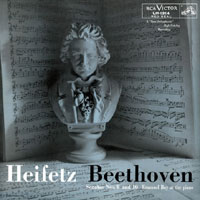Beethoven • Sonatas Nos. 8 and 10
Less noticed during this period are Beethoven’s contributions to the evolution (some say transformation) of the violin sonata from a simple form of chamber music to the showpiece it grew to be in the 19th century and where it remains today. Prior to Mozart it wasn’t unusual to hear the violin part in a violin sonata as the ornamental amanuensis of the piano’s right hand. Slight variations on the piano’s melodic line were easy to churn out as salon background music, but it lacked invention and challenge for the violinist. Picking up where Mozart began, Beethoven, first in his No.5 "Spring" sonata and more so in the Sonata No.8 (the final of three in his Opus 30), established an equanimity between the piano and violin parts while seeking to integrate (rather than subordinate) the higher-register violin with the new six-octave range of the evolving piano. Rather than the violin following the piano, in the opening Allegro movement of Sonata No.8, the instruments begin together with rambunctious trills and scales and then move as equals to chirpy dialogue. The Tempo di Minuetto is somewhat mechanical with polite restraint, yet we hear wistful hints that suggest Beethoven looking back to better days. The final Allegro vivace lights up with an enthusiasm of forward momentum. It's inspired by a peasant dance, the plates cleared, the tables moved back as piano and violin boogie to a happy end. The piece is fulfilling for both instruments and charming with a simplicity that keeps it ever fresh. Sonata No.10 was Beethoven’s last effort in the genre. His preceding ninth was the dazzling Kreutzer where the violin finally gains ascendancy, a place it would grow to enjoy in the future. While No.9 looks forward, No.10 does not look back, though it favors neither instrument. Beethoven finished it specifically for the famous French violinist Pierre Rode, newly arrived in Vienna. But Rode wasn’t the same master as in his youth. While Beethoven lured Rode to play his music, No.10 was really written for Beethoven’s longtime sponsor Archduke Randolph, who got to play it with Rode in the piece’s debut. Beethoven dialed back the finale to accommodate Rode, and gave neither instrument prominence to keep the Archduke in the loop. Sometimes art is the handmaiden of sponsor happiness; sometimes it just pays the rent. If No.8 is light-hearted, No.10 is meditative, its dialogue between instruments playful yet intimate with a reflective lyricism not previously heard in Beethoven’s violin sonatas. Coming when it does one might understand it as a finale in Beethoven’s journey from pain to serenity. The opening Allegro moderato is occasionally dreamy but generally paces true to its name. The Adagio offers introspective beauty, then the Scherzo awakens as the violin and piano chase one another as in courtship on a midsummer's day, each pursuing and pursued but with a restraint of innocent sweetness, neither foisting to the fore. The Paco allegretto shows brief urgency but quickly subsides to find the pair in the tranquility of a pleasant picnic in a clearing as they feed one another melodic biscuits, mooning and cooing between sips of tea. In a classic Beethoven conclusion, the players break their dialogue, the violin moving in circles as the piano dances a jig. Here, the violinist is the unmistakable Jascha Heifetz, the new Paganini with a lifetime RCA contract, the performer above whose name no other ever appeared, a musician expected to take the lead, and his performance on the 1952 RCA mono Plum Dog is no exception. Heifetz stands close to the single microphone with longtime accompanist Emmanuel Bay behind at some distance. Bay recorded nine of the ten Beethoven sonatas with Heifetz and understood his role as hired hand. He never outplayed his part. Despite lacking the equality of place called for by Beethoven’s score (as one hears, for example, with the Perlman/Ashkenazy pairing for these duets) there is an obvious chemistry between Heifetz and Bay. Neither sonata is technically demanding, nor does Heifetz attempt to turn them into something they are not. But the virtuosity is unmistakable, as the maestro uses his agility, his immaculate sense of pitch, and his split-second ability to diversify the speed of his bow and his vibrato, while remaining faithful to the dynamics and shadings of the scores. Hear how he and Bay work together to bring forth the dramatic tension and pace of the outer movements of Sonata No.8. No.10 avoids bravura passages, but listen closely to Heifetz’s Adagio to hear a violin played with supreme technical prowess in service to contemplative beauty. With only the faintest hint of 60-year-old master-tape
noise, the recording is transparent and open with a sound that is modern, not archival,
partly thanks to better vinyl. Surfaces were perfect, and it was a delight to hear the
rich harmonics spilling off Heifetz’s violin. Kudos to mastering masters Kevin Gray
and Robert Pincus for delivering better-than-the-original sound and likewise to the rest
of the Imprex staff for recognizing this gem and taking the chance on a mono recording of
chamber music. |

 ritten in 1802 and 1812,
the violin sonatas on this Impex reissue bookend a time of tremendous creative output in
Beethoven’s life, a time when the composer faced down his inevitable total deafness,
embarked on a self-proclaimed "new way" and composed some of the best-known
works in the classical canon: the Apassionata and Waldstein piano sonatas, his Violin
Concerto, and most famously his Third, Fifth and Sixth Symphonies.
ritten in 1802 and 1812,
the violin sonatas on this Impex reissue bookend a time of tremendous creative output in
Beethoven’s life, a time when the composer faced down his inevitable total deafness,
embarked on a self-proclaimed "new way" and composed some of the best-known
works in the classical canon: the Apassionata and Waldstein piano sonatas, his Violin
Concerto, and most famously his Third, Fifth and Sixth Symphonies.